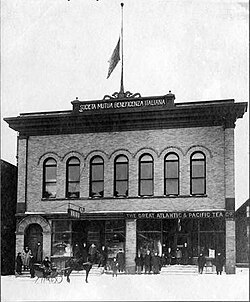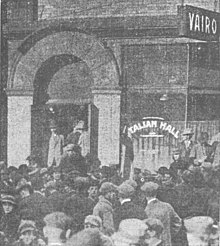
Alexander Emmanuel Rodolphe Agassiz, son of Louis Agassiz and stepson of Elizabeth Cabot Agassiz, was an American scientist and engineer.

Hancock is a city in the Upper Peninsula of the U.S. state of Michigan. The population of Hancock was 4,501 at the 2020 census. The city is located within Houghton County, and is situated upon the Keweenaw Waterway, a channel of Lake Superior that cuts across the Keweenaw Peninsula. Hancock is located across the Keweenaw Waterway from the city of Houghton, and is connected to that city by the Portage Lake Lift Bridge. The city is located within Michigan's Copper Country region.

Houghton County is a county in the Upper Peninsula in the U.S. state of Michigan. As of the 2020 census, the population was 37,361. The county seat and largest city is Houghton. Both the county and the city were named for Michigan State geologist and Detroit Mayor Douglass Houghton.

Calumet is a village in the Upper Peninsula of the U.S. state of Michigan. The village is located within Calumet Township, Houghton County, and had a population of 621 at the 2020 census.

Calumet Township, officially the Charter Township of Calumet, is a charter township of Houghton County in the Upper Peninsula of the U.S. state of Michigan. The population was 6,263 at the 2020 census. Even with a decreasing population, the township remains the largest township by population in Houghton County.

The Italian Hall disaster was a tragedy that occurred on Wednesday, December 24, 1913, in Calumet, Michigan, United States. Seventy-three people – mostly striking mine workers and their families – were crushed to death in a stampede when someone falsely shouted "fire" at a crowded Christmas party.

Finlandia University was a private Lutheran university in Hancock, Michigan. It was the only private university in the Upper Peninsula. Founded in 1896 as The Suomi College and Theological Seminary, it was affiliated with the Evangelical Lutheran Church in America. The university closed after the spring semester of 2023 due to enrollment and financial challenges.

Keweenaw National Historical Park is a unit of the U.S. National Park Service. Established in 1992, the park celebrates the life and history of the Keweenaw Peninsula in the Upper Peninsula of the U.S. state of Michigan. It is a federal-local cooperative park made up of two primary units, the Calumet Unit and the Quincy Unit, and almost two dozen cooperating "Heritage Sites" located on federal, state, and privately owned land in and around the Keweenaw Peninsula. The National Park Service owns approximately 1,700 acres (690 ha) in the Calumet and Quincy Units. Units are located in Baraga, Houghton, Keweenaw, and Ontonagon counties.

The Calumet Theatre is a historic theatre located at 340 Sixth Street in the town of Calumet, Michigan. It is also known as the Calumet Opera House or the Calumet Civic Auditorium. It is integral to, but a separate unit of, the Calumet municipal building. The structure was designated a Michigan State Historic Site in 1971 and added to the National Register of Historic Places in 1971. It is one of the 21 Heritage Sites which partners with the Keweenaw National Historical Park. The theatre was the original home of The Red Jacket Jamboree, an old-time radio variety show.

The Calumet and Hecla Mining Company was a major copper-mining company based within Michigan's Copper Country. In the 19th century, the company paid out more than $72 million in shareholder dividends, more than any other mining company in the United States during that period.

James MacNaughton, also variously known as "the King of Houghton County", the "Czar of the Copper Country" or simply "Big Jim" was an American business executive. He was general manager and the third president of the Calumet and Hecla Mining Company, including during the Copper Country Strike of 1913–1914.
The Copper Country strike of 1913–1914 was a major strike affecting all copper mines in the Copper Country of Michigan. The strike, organized by the Western Federation of Miners, was the first unionized strike within the Copper Country. It was called to achieve goals of shorter work days, higher wages, union recognition, and to maintain family mining groups. The strike lasted just over nine months, including the Italian Hall disaster on Christmas Eve, and ended with the union being effectively driven out of the Keweenaw Peninsula. While unsuccessful, the strike is considered a turning point in the history of the Copper Country.

The Calumet Historic District is a National Historic Landmark District that encompasses most of the village of Calumet, Michigan. The district was designated in 1989 for the community's importance in the history of the region's copper mining industry.

The Calumet and Hecla Industrial District is a historic district located in Calumet, Michigan and roughly bounded by Hecla & Torch Lake Railroad tracks, Calumet Avenue, Mine and Depot Streets. The district contains structures associated with the copper mines worked by the Calumet and Hecla Mining Company, located along a line above the copper lode, where railroad tracks connected separate mine heads. The Historic District is completely contained in the Calumet Historic District and the Keweenaw National Historical Park. It was designated a Michigan State Historic Site in 1973 and was listed on the National Register of Historic Places in 1974.

The Calumet Fire Station is a firehouse located on 6th Street in Calumet, Michigan. It is also known as the Red Jacket Fire Station. The building was designated a Michigan State Historic Site in 1971 and listed on the National Register of Historic Places in 1974, and is part of the Calumet Historic District and the Keweenaw National Historical Park. The building now houses the Upper Peninsula Fire Fighters Memorial Museum.

The Quincy Smelter, also known as the Quincy Smelting Works, is a former copper smelter located on the north side of the Keweenaw Waterway in Ripley, Michigan. It is a contributing property of the Quincy Mining Company Historic District, a National Historic Landmark District. The smelter was built in 1898 by the Quincy Mining Company, operating from 1898 to 1931 and again from 1948 to 1971. The smelter was part of a Superfund site from 1986 to 2013.
The Osceola Mine was a copper mine consisting of 11 shafts located in Osceola Township, Houghton County, Michigan. In 1895, it was the site of the deadliest mine disaster in the Copper Country.

The Scott Hotel is a former hotel located at 101 East Quincy Street in Hancock, Michigan, originally known as the Hotel Scott. As of 2009, it is also known as the Scott Building. The five-story building is in the Renaissance Revival style, constructed of tan brick and trimmed with Lake Superior Sandstone. The building is listed as a Michigan State Historic Site and is a contributing property of the Quincy Street Historic District.

Anna "Big Annie" Klobuchar Clemenc was an American labor activist. Born in Calumet, Michigan, she founded and served as president of the local Women's Auxiliary No. 15 of the Western Federation of Miners and was an active participant in the Copper Country Strike of 1913–1914. She is an inducted member of the Michigan Women's Hall of Fame.


























